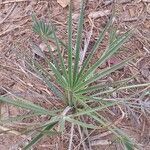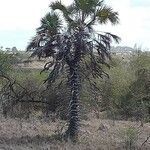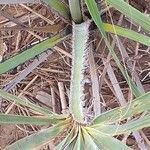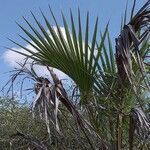Trunk ultimately reaching 20–30 m. tall, swollen at very base (85 cm. diameter), ± 40–50 cm. diameter at breast height, often with pronounced swelling to 80 cm. diameter about 10 m. above the base, at first covered with persistent leaf-bases, these eventually falling to leave a grey surface, marked with annular leaf scars.. Leaves ± 40 in the crown at maturity; leaf base ± 90 cm. long, split longitudinally down the mid-line, eventually also splitting opposite the petiole; petiole to 3.25 m. long by 15 cm. wide above the base, and 3 cm. thick, tapering to 7.5 cm. wide and 3 cm. thick near the lamina insertion, rounded abaxially, flattened or concave adaxially, edged with shiny, black, irregularly erose, sharp protuberances to 1–2 cm. high; adaxial hastula only slightly asymmetrical, ± 1 cm. high; abaxial hastula inconspicuous, ± 3 mm. high; costa short, ± 10 cm. long, the blade hence slightly costapalmate; blade radius ± 180 cm. from hastula to apex, shorter in outer regions; segments 60–80 or more, not all held in the same plane, stiff and only drooping at the tips in age, in length equalling ± half the radius, 5 cm. or more wide, bifid apically for up to 15 cm., with numerous very fine longitudinal veins, distinct lateral veins, and minute distant pale brown scales.. Male inflorescence to ± 1.5 m. long with 3–6 partial inflorescences; peduncle ± 50 cm. long, ± 3 cm. in diameter at base; bracts tubular, to 45 cm. long by 7 cm. wide, coriaceous, finely striate, split to ± 17 cm., distally the first few bracts empty, the upper subtending branches terminating in (1–)3 rachillae; rachillae up to 35 cm. long by 3 cm. in diameter, brownish green, densely covered in ± 8 spirals of imbricate bracts, free portion of bracts about 10 mm. wide by 5 mm. high; cincinni bearing ± 9 flowers, emerging from the pit one at a time.. Male flowers subtended by 2 small bracteoles ± 3 mm. × 1 mm.; calyx to 7mm. long, tubular, with 3 very shallow to deep lobes; receptacle to 7.5 × 1 mm., bearing 3 small rounded somewhat cucullate corolla-lobes ± 2 mm. long; stamens 6; filaments very short bearing anthers ± 2 mm. × 0.5 mm.; pollen yellow.. Female inflorescence ± 1–1.5 m. long, bearing 2–3 empty bracts to 50 cm. long by 7 cm. wide, occasionally branched once or twice; flower bearing portion of axis ± 50–75 cm. long, ± 4–5 cm. in diameter; bracts densely crowded, 3 cm. high by 12 cm. wide, connate laterally and forming pits.. Female flowers solitary, borne with 2 bracteoles, each 2 cm. high by 3 cm. wide; sepals 3, imbricate, ± 1.5 × 2 cm.; petals 3, imbricate, ± 1 × 1.5 cm.; staminodal ring with 6 teeth to 4 mm. high; ovary ± 1 cm. in diameter, tipped with 3 stigmatic areas.. Ripe fruit usually dull orangey brown, somewhat shiny, borne with the much enlarged calyx and corolla; sepals in fruit 6 cm. high by 10 cm. wide; petals in fruit 7–8 cm. high by 12 cm. wide, erose-margined; fruit broadly ovoid, usually flat-topped, shape depending on number of seeds developing and on close-packing in the infructescence, up to 12 cm. high by 14 cm. in diameter or more, obscurely 3-angled; mesocarp up to 1 cm. thick, yellow and fragrant when ripe, with numerous longitudinal fibres embedded in soft pulp; pyrenes up to 3, 10 × 10 × 5 cm., with endocarp ± 7 mm. thick with 2 radially aligned internal longitudinal flanges, the outer to 1 cm. high the inner to 5 mm., penetrating the seed.. Seeds 1 in each pyrene, with hard bony white homogeneous endosperm, almost completely filling the pyrene-cavity except for a small central space; embryo apical, top-shaped, ± 5 mm. long by 4 mm. wide.. Fig.2.
More
A solitary fan palm. It grows up to 25 m tall. It has separate male and female trees. The trunk is bottle shaped and smooth. Older trees have a swelling on the trunk above the middle which helps distinguish it from Palmyra palm. The bark is grey. Young trees have leaf bases which cling to the tree. The leaf scars are prominent. The terminal crown is a cluster of fan-shaped leaves. The leaves are up to 4 m long including the leaf stalk. The leaf is divided about the middle into folded segments. The leaf stalks are black with hooked spines along the edges. The flower comes from between the leaf stalks. The male flower spike is 2 m long with branches which are 25 cm long by 4 cm across. The female flower spike is 1.5-3 m long and unbranched. There are 20-50 fruit. The fruit are round and about 15 cm across. They are green to orange. The base of the fruit are enclosed in 6-7 cup shaped bracts. The fruit contain 3 hard coated seeds. The individual fruit is about 1 kg weight and the seeds 100 g.
Tree, up to 20 m high. Bole straight with a swelling ± halfway up. Leaves fan-shaped, 3-4 m long. Fruits 120-180 mm in diameter, orange-brown when mature.
The tallest of African palms, often 70 ft. high and sometimes as much as 100 ft.
The palm is dioecious, the female conspicuous by its large orange fruits.
Trunk swollen above the middle





